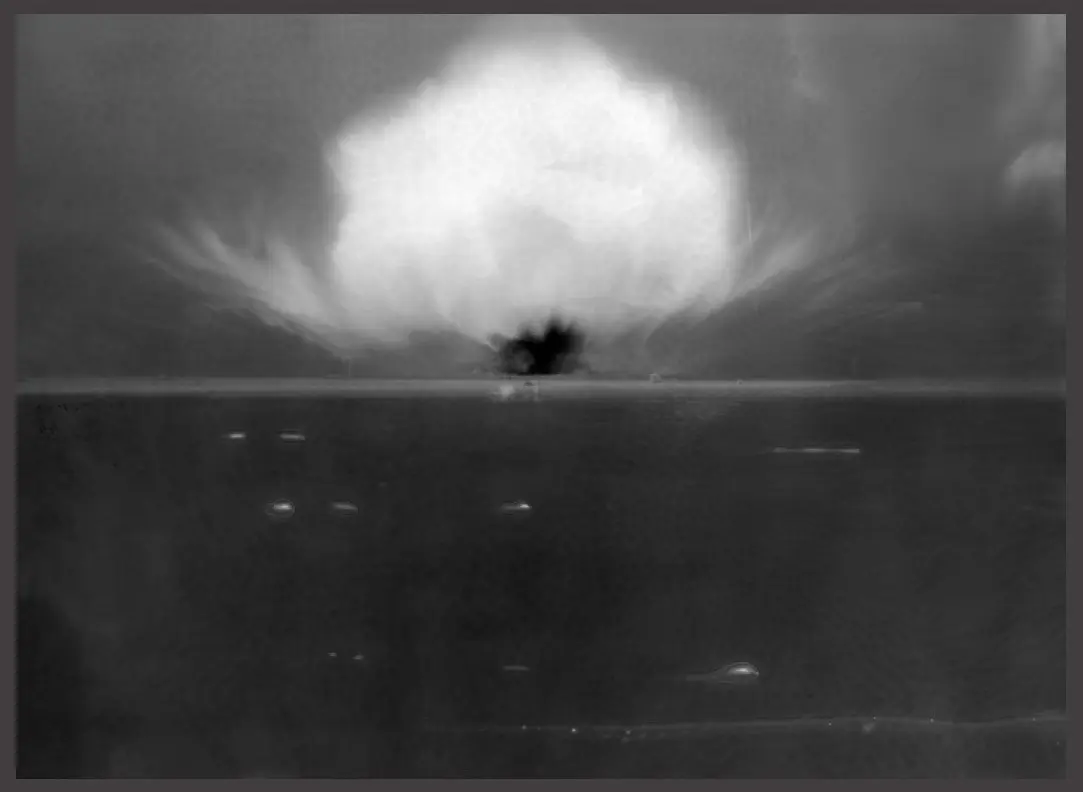Earth is heating at a rate equivalent to five atomic bombs per second. Or two Hurricane Sandys.
By Dana Nuccitelli, February 3, 2020


Long-exposure photo of the first atomic bomb test, code-named Trinity, and taken at 5:29:45 a.m. on July 16, 1945.
The heat absorbed in Earth’s oceans reached a new record in 2019, found a recent study published in the journal Advances in Atmospheric Sciences. Despite the fact that this has been the case for almost every year over the past decade, this information dominated the news cycle, with some particularly viral headlines noting that the amount of energy accumulating in the oceans is equivalent to detonating five Hiroshima atomic bombs per second, every second over the past 25 years.
While stunning, this isn’t a new analogy. After we published a paper about Earth’s energy accumulation in 2012, my colleagues and I at Skeptical Science created a website that provided a widget that websites can include on their homepages to illustrate the amount of heat accumulating on Earth as compared to the energy in the Hiroshima atomic bomb. The widget also uses other analogies to get the idea across, such as how the amount of heat accumulated compares to the energy in Hurricane Sandy, or 6.0 magnitude earthquakes, or Big Bens full of dynamite, or millions of lightning bolts. Improved ocean heat measurements have since revised the rate of warming upwards from four to five ‘Hiros’ per second. (For the record, as of the writing of this article, our climate has accumulated the equivalent of a total of more than 2.8 billion Hiroshima bombs’ worth of heat since 1998.)
Our team wasn’t the first to use this analogy. In 2010, oceanographer John Lyman compared the rate of ocean warming to atomic bombs, and James Hansen used the Hiroshima atomic bomb analogy in his February 2012 TED talk. One might say that the comparison has come under heat, however. Some criticize the analogy for exploiting or being insensitive to the horrors suffered by the people of Hiroshima. Others have complained that the analogy is imperfect, as all analogies are, by definition.
On the other hand, the use of Hiros has one major upside. Earth and especially its oceans have been accumulating such a vast amount of heat due to human-caused global warming that it’s difficult to comprehend. Most people have little if any sense what 10 zettajoules per year—the amount of heat energy absorbed per year by the Earth—means. That’s why climate communicators have searched for a metric of comparison that the public can grasp. It’s relatively easy to visualize five atomic bombs detonating every second, and consequently comprehend the vast amount of energy being absorbed by the Earth’s climate system.
For those who nevertheless object to the Hiros analogy, perhaps microwaves offer a more palatable comparison. The heat accumulating in Earth’s oceans over the past 25 years is also equivalent to every person now on Earth running 35 standard household microwave ovens nonstop during Justin Bieber’s entire lifetime.
Critically, the rate of global heating is also accelerating. During the prior 25 years (1968–1992), the oceans only warmed at a rate equivalent to one Hiroshima bomb detonation per second, or 7.7 billion people each running 10 microwaves nonstop during that quarter-century period.
The good news: the rate at which we’ve been adding heat to Earth’s climate hasn’t changed much over the past two decades. The bad news: to avoid a potential climate catastrophe, global heating needs to begin declining soon and rapidly, which will require international implementation of numerous ambitious climate policies.
So far, many governments appear more inclined to keep increasing fossil fuel extraction than taking the necessary steps to slow global heating. Political leaders in many countries can implement these destructive policies without fear of losing power because too few people grasp the urgency of the climate crisis. Perhaps visualizing global heating as five atomic bomb detonations per second will help convey that sense of urgency to more people.
As the coronavirus crisis shows, we need science now more than ever.
The Bulletin elevates expert voices above the noise. But as an independent, nonprofit media organization, our operations depend on the support of readers like you. Help us continue to deliver quality journalism that holds leaders accountable. Your support of our work at any level is important. In return, we promise our coverage will be understandable, influential, vigilant, solution-oriented, and fair-minded. Together we can make a difference.
View Comments
When did atomic bombs and hurricanes become official units of measure? Just used to frighten the goober faithful? Real science would specify kJ or Btu. OK, I see 10 zettajoules per year. I got 3.9. Here, I'll even show my work.
6,371.00 km radius
6,371,000.00 m radius
1.27516E+14 m^2 cross sectional area, PI * r^2
1,368.00 W/m^2 ISR
957.60 W/m^2 ASR net 30% albedo
3,447.36 J/h/m^2 W = 3.6 J/h
4.396E+17 J/h
8,760.00 h/y
3.85084E+21 J/y
1E+21 zetta
3.851 zetta J
So exactly nowhere in this fear mongering article are the Joules per 4 atom bombs or 2 hurricane Sandys even mentioned.
Is that because Dana didn't bother to find out? Didn't want to share? Is the rest of his math just as bad? Or is he just fundamentally full of …..
I'm neither a scientist nor an especially math literate reader. The headline got my attention. I read the article. I believe I am more informed than I was before clicking.
I particularly concur with this part of the article: "Most people have little if any sense what 10 zettajoules per year—the amount of heat energy absorbed per year by the Earth—means. That’s why climate communicators have searched for a metric of comparison that the public can grasp."
Yes.